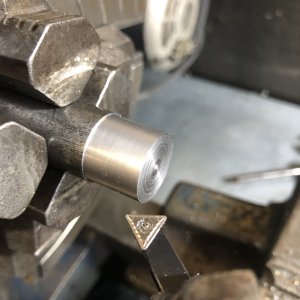- Joined
- Sep 12, 2020
- Messages
- 56
Some other thoughts, I sorta think slow(er) these days.
1,2: It is definitely a 12 inch swing machine. The distance between centers is a close approximation for the other half of the size. As I stated, mine is a 12x36, for what that's worth. I think that for a while, the Craftsman line had 12, 24, and 36 inch between centers. The "10D-247" is a casting number. It would reference an Atlas part (original manufacturer) that may well fit a number of machines. The "101.07361" is a part number for Craftsman, in this case a complete machine. It will indicate a date range only in when Sears sold that particular machine. As I stated, mine is a 101.27440, a later model that dates to the early 50s. Craftsman lathes were built by Atlas with an extra 1" above the bed. They are otherwise virtually identical to the Atlas line.
3: I didn't see any serious vibration in the video. Such a judgement is highly personal. Having run it without the chuck, any vibration must come from a pulley out of balance. Or possibly the motor. . . A single phase machine doesn't run as smooth as a 3 phase does. I have retrofitted the original retrofit motor on mine. I used a 1/3 HP Baldor "Farm Duty" motor, simply because I like that motor. The original Craftsman motors (I have several) had a "flat pack" capacitor which is not a standard part. Finding a replacement is a hit or miss proposition, on a good day. The simplest solution is to replace the motor with known, available parts. "V belts" are your call. I would recommend machine belts as opposed to automotive belts. Though in the past, I have run a nylon stocking in an emergency. Back in the early 70s in the Arizona desert. Ya do what ya gotta do. . .
4: The 8" chuck is at the high end. I have a 4" and a 5" 3 jaw and a 5" 4 jaw scroll chuck, as well as the 8" 4 jaw independent. I also have, through an adapter, a 2-1/2" scroll chuck and a 3" 4 jaw independent. But they are specific to my work with small models. Not normally seen on serious machines. The thing to watch for is as the jaws extend beyond the chuck body they don't come in contact with the bed frame. Always rotate the machine one full turn by hand before powering it up. A 5" is a good, safe chuck for generic work.
5: 1/4" tooling is my norm. 0.025 depth of cut (DOC) is about the maximum my machine will handle. Larger tools are more rigid, but the Craftsman itself isn't that rigid. I also use a lot of 3/16 and 1/8 tooling. As well as many I have ground out of old drills for specific uses. As a startup, 1/4" tooling is fine. Although you can go larger, there really is no need. Same for smaller tools, you'll try to do something and the tool is too large. That's when you'll start grinding your own.
As an aside, carbide tooling is great for removing large amounts of metal in a hurry. But for finer finish work you may fine tool steel to be more useful. Learn to grind tool steel tools. It will save your bacon on occasion.
Edit: Afterthoughts:
The spindle pulleys have a couple of internal mating surfaces. There is one pulley, I don't recall which one, that has a setscrew that is actually an oil hole. Lube it well and replace the setscrew. Do not bottom the setscrew, just set it deep enough to close the hole. There is a "dog" that releases for running in back gears. It must be fully engaged or disengaged in use. And lastly there is another dog on the front, right, lower head stock that sets a 60 point hole circle for indexing. That dog must never be used when power is on the machine.
Lastly, it sounds like a burr or bad dirt, or a mismatch in the change gears. If there was a quick change box, I would say look there. I had to rebuild mine when I got it. Make sure the machine is out of gear.
.
Thank you sir for your tips and insights
#3 - On the vibration, I guess I just "don't know what I don't know" I figured that was a decent amount of vibration, but it may not be for this machine.
I'll check out the pulleys
I was able to mess around with it some more this afternoon and get these results. First time I was able to make some chips.. so I'm happy. The power feed is handy...



